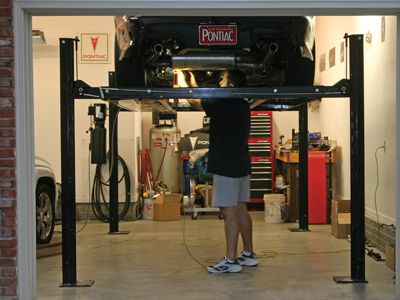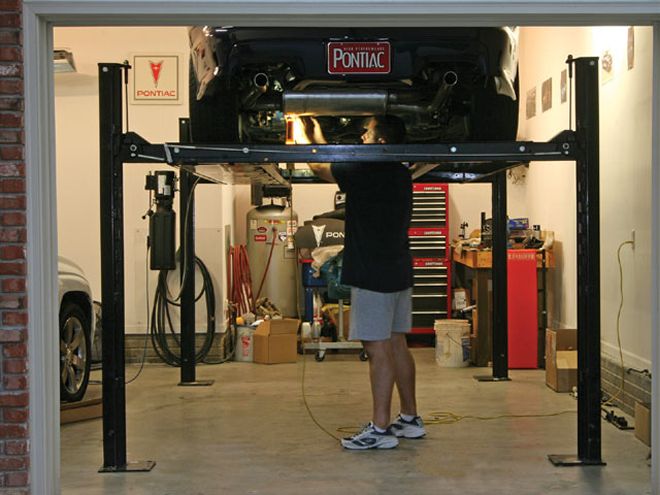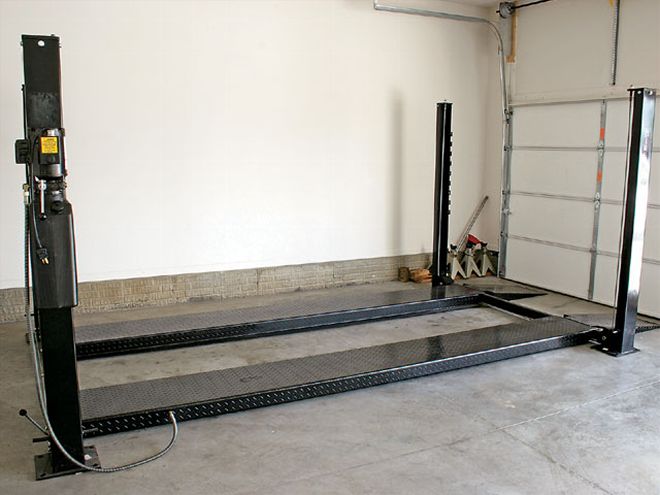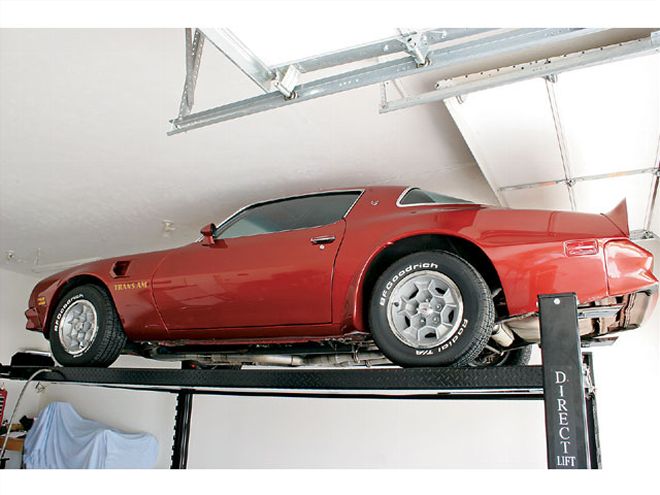

Besides an air compressor and wide array of hand tools, what else separates a professional repair garage from that of an average hobbyist? There's certainly any number of answers to that question, but an automotive lift will likely be among the replies most commonly heard.
While a lift may not seem practical for some home hobbyists, work under your Pontiac just once while standing instead of lying on the cold, hard floor, and you'll likely start searching for ways to add one to your arsenal. Follow along as we discuss some of the decisions associated with purchasing an above-ground automotive lift, and provide a few helpful tips maximizing space within your garage.
Types Of Lifts
Automotive lifts are designed to safely raise a vehicle and provide complete access to the entire underbody for repairs, and those intended for hobbyist use can be broken down into two major types-two-post and four-post. So what's the difference, and which is best for you? That depends largely on the work you do most, and your garage flooring.
Two-post lifts consist of two vertical columns with a pair of adjustable arms extending horizontally towards the center. Lift pads on each arm are then positioned under the vehicle's frame, and when raised, allow the suspension to hang freely, making this type most desirable for suspension-related repairs. While two-post lifts take up the least amount of floor space, the columns must be anchored to the concrete, and this can require specific floor preparation.
 Two-post lifts must be anchored to the floor and require a minimum floor thickness of approx-imately 6 inches of high-tensile concrete. After countless considerations, we ultimately settled on a four-post unit from Direct Lift. Our model is fairly compact, contains a maximum capacity rating of 7,000 pounds, operates on a household 110-volt current, and can raise a vehicle to a maximum height of 6 feet in a little more than a minute-for around $2,000. Though this unit doesn't need to be anchored down, it's an option we plan to exercise in the near future. Also, casters attached to each column provide complete mobility.
Two-post lifts must be anchored to the floor and require a minimum floor thickness of approx-imately 6 inches of high-tensile concrete. After countless considerations, we ultimately settled on a four-post unit from Direct Lift. Our model is fairly compact, contains a maximum capacity rating of 7,000 pounds, operates on a household 110-volt current, and can raise a vehicle to a maximum height of 6 feet in a little more than a minute-for around $2,000. Though this unit doesn't need to be anchored down, it's an option we plan to exercise in the near future. Also, casters attached to each column provide complete mobility.
Four-post lifts consist of four vertical columns and two horizontal drive-on ramps that the operator positions the vehicle onto. Though the vehicle continues to support its own weight, suspension work can be performed with the use of smaller jacks in strategic locations. A distinct drawback to a four-post lift is the amount of floor space it requires, but because there are more columns to evenly disperse a vehicle's weight, they do not necessarily require anchoring, and are oftentimes more compatible with the concrete flooring found in a typical home garage
Garage Space And The Decisions
While designing our ranch-style home, we discussed with custom builder Rick Marasco, of Marasco Homes in Omaha, Nebraska, our plans for a shop-type atmosphere, and the possibility of an automotive lift in the future. His suggestions included an enlarged version of his standard three-car garage, with climate control, reinforced cement flooring, and a maximum ceiling height of just under 12 feet.
After searching various manufacturer's Web sites and garage-based Web forums, and visiting several local area repair shops soliciting pro-fessional opinions, we ultimately chose a four-post lift for our garage. Not only could we still complete virtually any task, but casters (optional on most models) make it mobile should it ever need to move, and it can reliably support a vehicle for extended periods, effectively creating enough space to store another vehicle under it.
Armed with the manufacturers' stated space requirements of those being considered, we constructed cardboard templates representing the exact footprint of each lift, and noted the proximity to several objects including the walls, exterior garage door, and nearest parked car. We then narrowed our selection down to those that left the greatest work area within our garage, yet had a maximum weight capacity well beyond that of our heaviest vehicle, and made the purchase.
Adding A Lift
After closely following the manufacturer's assembly instructions, we began positioning the lift in our garage, allowing maximum possible clearance in every direction. That brought us to our next obstacle-the conventional, drawbar-type garage door opener connected to the extension-sprung exterior door of the third-car bay.
We knew going in that the electric opener would have to be removed, and planned on manually operating the existing door-but that wasn't the problem. When open and in a horizontal position, the door was just 8 feet off the ground, which meant that it couldn't be open while working under a vehicle. Knowing we'd never be satisfied with that arrangement, we contacted Steve Gulizia, of The Door Doctor in Omaha, Nebraska, and solicited another professional opinion.
 Many homeowners never realize that their current garage contains ample space to accommodate a lift. To determine the approximate work area under a vehicle, subtract the vehicle's peak height from the minimum ceiling height. If the work area is greater than your personal height (how tall you are), you should be able to easily stand under the vehicle. When dealing with taller vehicles, a roll-around stool is an option-being seated while working under a car is still better than lying on your back!
Many homeowners never realize that their current garage contains ample space to accommodate a lift. To determine the approximate work area under a vehicle, subtract the vehicle's peak height from the minimum ceiling height. If the work area is greater than your personal height (how tall you are), you should be able to easily stand under the vehicle. When dealing with taller vehicles, a roll-around stool is an option-being seated while working under a car is still better than lying on your back!
In an attempt to gain maximum clearance, Gulizia suggested converting the extension-sprung door to a torsion-sprung set up, and increasing the length of the door tracks to position the open door much closer to the ceiling. He also mentioned a relatively new product he thought might interest us-a Chamberlain Liftmaster 3800 Jackshaft electric door opener. It's an affordable wall-mounted unit that connects to the door's torsion shaft, providing full automatic operation without compromising ceiling clearance. After considering all the benefits, we heeded Gulizia's advice, and proceeded with the install.
Exercising Extreme Caution
Like any piece of equipment with moving components, personal safety should be of the utmost concern while using a lift, and periodic maintenance and regular inspections are required to ensure maximum reliability from it.
Failure to follow the manufacturer's instructions in their entirety, which should be clearly spelled out in the supplied manual, could not only result in severe damage to a vehicle, but serious bodily injury too. If any unanswered questions remain, we strongly suggest contacting the manufacturer and addressing any concerns directly with the company prior to using a lift for the first time.
Conclusion
In the past, to complete various projects, we had to make arrangements to use a friend's lift after normal business hours, but after completing a few tasks at our own leisure, it's clear how invaluable a lift truly is. From basic oil changes to complete transmission or suspension swaps, any task is much simpler. If you've pondered purchasing a lift in the past, and discover that you have ample space in your garage, consider all the benefits an automotive lift has to offer. You'll soon be performing repairs on your Pontiac that you once had to pay for!